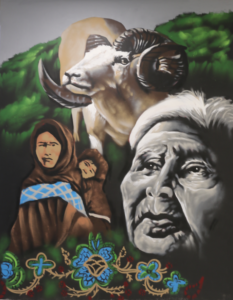Members of the Alaska Pacific University community gathered Wednesday, July 26th to recognize APU supporters and witness the unveiling of Haida artist Andrew Morrison’s mural in Atwood Center.
The ceremony opened with a welcome from Interim President Dr. Robert Onders, who named new Denali Society members, those who have given more than $1,000 to the university, and those who have moved up in giving tiers.
LeeAnn Garrick, APU’s Board of Trustees Chairperson, then awarded the Laurence J. Carr Volunteer of the Year Award to Evan Rose. The award was established in 1999 to recognize volunteers who have made substantial commitments of time and resources to APU. Evan’s father, Dave Rose, received the award in 2000. His company, Alaska Permanent Capital Management began performing pro bono investment management functions for operating funds of APU in 1995. When Dave passed in 2006, Evan wanted to honor his father’s legacy and continued to perform management services pro bono for the APU Foundation.
Beyond that, Evan Rose has personally supported APU for nearly 20 years through participation in the President’s Forum, APU Gala, APU Nordic Ski Center, and Alumni Association.

Ed Rasmuson recognized as donor and volunteer.
Another former Laurence J. Carr Volunteer of the Year Award recipient was recognized as well. Ed Rasmuson, a 2013 Volunteer Award recipient and a Trustee of APU for 27 years had the hall on the second floor of Atwood Center where the event took place formally named after him, in honor of the time and the millions of dollars the Rasmuson family has donated to APU.
The reception wrapped with words from Andrew Morrison, the artist commissioned to paint the mural.

The artist and his finished work.
He explained that the leftmost panel of six panels acts as a launching point to the series. The composite of three ancient masks (one from Northern, one from Southwestern, and one from Southwestern regions of Alaska) and the basket of berries, all atop a silhouette of the state is meant to unify the various regions.

The entry piece to the mural.
From there the other five panels represent five regions of Alaska and their cultural groups.
“The Alaska Native people are made up of many diverse cultures, but to simplify for this project, they are represented by five distinct areas and people groups: Southeast Alaska, the Aleutian Islands, the Inupiaq, the Yupik, and the Athabascan People,” Morrison explained.
The second and third panels represent both the Yupik and Inupiaq people.

Those panels show tribal elders and northern lights on the left and a traditional King Island dancer in the foreground and people participating in a blanket toss by a whale bone structure in the background on the right.

“That part is really subtle, which is what I like about it,” Morrison explained.

The final panel represents Southeast Alaska with a Tsimshian mask, a Tlingit woman in traditional regalia, and Charles Edenshaw, a famous Haida carver.


